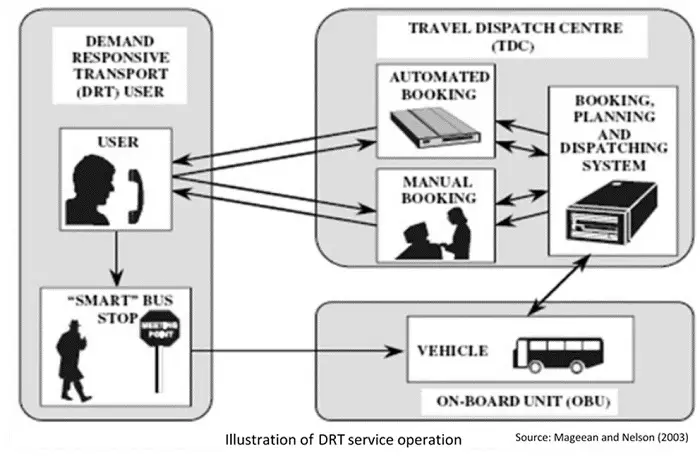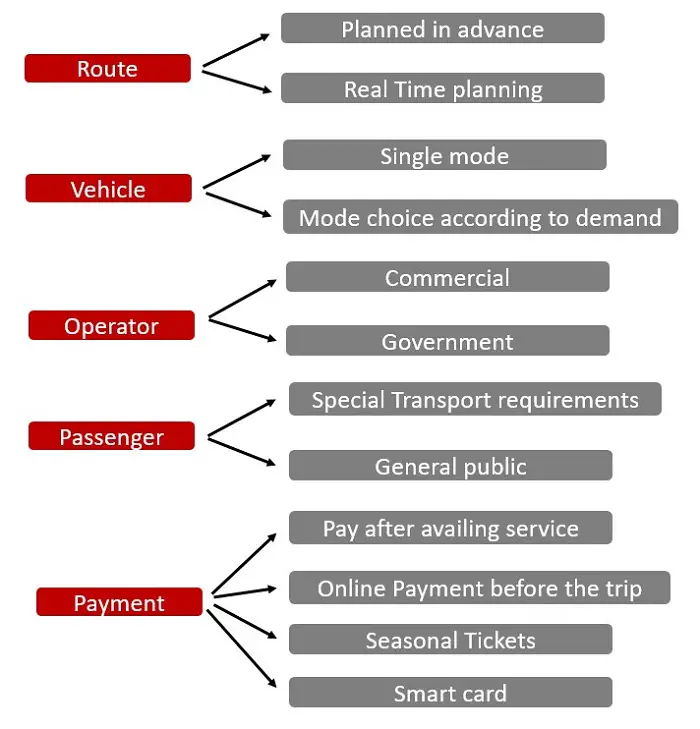Introduction
Demand responsive transit or DRT is a private or semi-public or semi-private transport service system. It is a paratransit which is an indistinct mass of Transport organizations or technology and services. It lies between the conventional Public transport and personal transport in price and quality. DRT can also be perceived as a combination of Public transport and private organized vehicles such cab, auto etc.
The concept of DRT has been in existence since 1970s in the world. However, it has become prevalent only in the recent years. Developed countries across numerous western countries along with Australia, Hong Kong, Japan have already executed the DRT concept. It can as well be referred as Demand Responsive Service, Dial-a-Ride Transit and Flexible Transport service.
It is a demand mobility service which fills a gap between Public and private Transport systems. This concept perceives mobility as a service, its character is passenger oriented. It is a flexible mode of transportation which functions according to the schedule of the user or passenger rather than the passenger adapting to the traditional public transport schedule. DRT services are allowed to be flexible on certain features such as Route, origin–destination pattern and timetable of the trips. This concept is useful for people with limited mobility, people living in an area which has less or no public transportation service for example a peri-urban area.
Related: Factors to consider when choosing mode of transport, Traffic Islands | Meaning, Use and Importance
Application Of DRT System
DRT is frequently operated as shared ride according to the passenger requisites. A fast, simple and personalized services is expected. In urban or semi-urban areas people are well versed with technology thus can use mobile applications to request for DRT services. The service is widely benefited by people of:
- Areas with low or no frequency of Public Transport: As populations fall in rural areas, it becomes harder to fund and maintain public transport links. These areas with low demand of public transport such as Semi-Urban areas and Rural areas are benefited.
- The Elderly and Physically handicapped: the rise in life expectancy has accompanied a rise in mobility impaired individuals. It would be a boon for them as they can ride with comfort, safety and privacy.
- The First and Last mile connectivity: DRT can also be used to effectively close the first and last mile problem, or serve as additional services when needed.
How Do DRT Services Work?
There are several Agencies, booking services and Mobile applications to request for service. They take in the location information of the passenger. An algorithm is used to match requirements. Vehicles and fleet drivers riding in the same direction are identified and given the pickup and drop-off information. The mobile application works with a route optimization software, which calculates journeys as per the fastest route using real-time data. The mobile app also allows passengers to save a particular journey, track the arrivals, and follow the route during their journey.
In a single tap, a public transport operator can handle arrangement of a dispatch, and/or routing of a vehicle to board arriving passenger’s requests. Operators can also decide to configure multiple service types like scheduling buses in fixed route system or directly to passenger’s doorsteps. In other cases, vehicles can run on a predetermined route without a fixed schedule. They can as well just stop only during a subset of prearranged stops, based on passenger requests.

DRT System Depends Upon:
- The flexibility of the mode to meet the users’ requirements about timetables and itineraries.
- The flexibility of vehicle fleet management so as to minimize empty vehicle trips.
- Applying new technologies to monitor vehicular locations and allow real time service planning and to enable information which is to be transmitted to the users to and from the vehicles.
- Selecting the best type of mode of vehicle to match the demand.
- Maximizing the level of integration with conventional public transport systems.
- Improving the relative performance of demand responsive transport in terms of cost and comfort compared to cars and traditional public transport alternatives.

Read about: Design principle for intersection, Level of Service
Strengths Of DRT
- Support citizens of rural population and citizens with limited mobility or special needs.
- Reducing the number of private vehicles on road, therefore reducing Carbon emissions which and improving transport flow.
- Increasing the modes of transit systems; Multimodal transport in Urban and Rural areas.
- Increasing first-mile and last-mile connectivity.
- Efficient and easy to use.
- Cost effective and cost efficient connectivity.
- It is Sustainable if a right sized vehicle is used as per the number of passengers.
Weakness Of DRT
- Online booking systems are not plausible or inadequate for people living in Rural areas.
- Creating efficient trips or rides with respect to the passenger demands is time-taking and sometimes can become a confusing task.
- If the DRT service is taken up by the government, the prices of the services would be low due to subsidy which might cross beyond the government grants.
- Lack of understanding about the scheme amongst the public.
- Uncertainty of the passenger demands because most of them are in real time.
- Low level of ridership.
- Uncertainty of behavioral changes of passengers and operators.
- There is a correlation between the size of a network to be connected and the choice of mobility, it is influenced by the distance to be covered and by the type of user and infrastructure present, if the correct vehicle is not used the prices will be high or there will be a loss in terms of monetary.
Opportunities For DRT
- An increasing feeling that conventional Public Transportation is inflexible and undependable, especially considering that individual requirements can vary over time.
- With the increasing sprawl, standard public transport can become unfeasible.
- Public officials are showing an increasing interest in DRT as a means for inclusion of some particular targets groups and also to achieve modal shift.
- In some places such as airport shuttles, they have already been proved to be commercially viable.
- In Europe, there is potential to use DRT in orbital journeys in suburban and Peri-urban areas whereas the conventional Public Transportation is used for radial routes.
- DRT could expand into goods delivery (e.g. of library books, prescriptions and post/parcels) as an additional source of income. There may also be unexplored potential for transport in the “night time economy”.
- The most important element of variable costs are the wage costs of the drivers (at least, in the schemes that are not volunteer-based). This issue will disappear with automated mobility, which will increase the potential of DRT as a feeder mode for high capacity public transport.
Challenges Of DRT
- If they are overly flexible in terms of schedule and /or route (and their travel times thus become too variable), they can become unsuitable to serve as feeder transport to public transport hubs in urban areas.
- On-line booking systems can make DRT more suitable for the general public, but not for the target audience who are of “socially motivated” DRT (such as elderly people or mobility impaired ones).
- The task of routing for DRT is very intricate to model and optimize. Some of these complexities arise from the tough to predict behavioral changes of operators and passengers or users such as late-running services or no-shows by the clients.
- Government undertaken DRT services perform taxi services at PT prices. As a result, they can be perceived as unfair competitors by traditional taxicab services.
- There is a strong perception in few countries that DRT is only for mobility impaired people despite the gradual extension of the scope of the services that are available. This hampers the inclusion of DRT in the standard public transport offer.
- DRT is not generally included in transport planning applications.
- Public transport companies are usually used to serve captive markets, when they undertake the provision of DRT services there is insufficient experience with their marketing for attracting new clients.
Author:
Siri Vydadi
Member of NOSPlan
School of Planning and Architecture, Vijayawada
References:
- https://www.here.com/solutions/urban-mobility
- https://www.interregeurope.eu/sites/default/files/2021-12/Policy%2520brief%2520on%2520demand%2520responsive%2520transport.pdf
- https://uft.lu/en/news/uft-news/what-is-demand-responsive-transit
- https://mobilitybehaviour.eu/2017/08/04/demand-responsive-transit-DRT/
- https://www.its.leeds.ac.uk/projects/konsult/private/level2/instruments/instrument048/l2_048a.htm
- https://www.researchgate.net/publication/42800012_Why_do_demand_responsive_transport_systems_fail